Atmospheric and Climate Sciences
Vol.3 No.4(2013), Article ID:36690,6 pages DOI:10.4236/acs.2013.34047
Gamma-Rays in Association with the Rocket-Triggered Lightning Caused by Neutron Bursts
Centro Brasileiro de Pesquisas Físicas, Rua Dr. Xavier Sigaud, Rio de Janeiro, Brazil
Email: gersonspaiva@ufpe.br
Copyright © 2013 Gerson S. Paiva et al. This is an open access article distributed under the Creative Commons Attribution License, which permits unrestricted use, distribution, and reproduction in any medium, provided the original work is properly cited.
Received April 2, 2013; revised May 5, 2013; accepted May 13, 2013
Keywords: Gamma-Ray; Deuterium; Rocket-Triggered Lightning; Nuclear Fusion
ABSTRACT
In this work, it shows that nuclear reactions in lightning channel, which are produced by the deuterium-deuterium (D-D) and deuterium-tritium (D-T) nuclear reactions, represent a plausible mechanism for gamma-ray bursts observed at ground. Gamma-ray emissions from lightning can be explained by neutron inelastic scattering in the air. Neutrons (produced in lightning channel) will delay a definitive time (~33 ms) to cover the atmosphere before hitting a molecule and producing gamma rays, which is somewhat longer than the gamma-ray time delay (~20 ms) observed at ground.
1. Introduction
Intense gamma-ray bursts on the ground, and produces in association with the initial-stage of rocket-triggered lightning, which have been recorded by Dwyer et al. [1]. These gamma-rays have energies extending up to more than 10 MeV. They are associated with a large current pulse of 11 kA occurring during the initial-stage (during the initial continuous current), about 20 ms after the vaporization of the triggering wire. In triggered lightning, the initial-stage is characterized by a steady current, preceding the return strokes, with superimposed pulses up to several kA in amplitude [2]. Many researchers have reported long duration (a few seconds) x-ray and gammaray emission from thunderclouds, but the majority of these observations were made in or near the cloud either using balloons or on top of high mountains [3-5]. Moore et al. [6] also reported gamma-ray emission, measured on a high mountain, associated with stepped leaders from nearby lightning strikes. At this point, it is not clear how the gamma-ray burst reported here relates to these earlier observations. However, based upon the duration, energy spectrum and inferred distance from the source, the gamma-ray burst may indeed be a new phenomenon. Acceleration of electrons to high energies in electric fields above thunderstorms was predicted in 1925 by Wilson [7] and this runaway process was shown to be capable of avalanche multiplication, making its variants good candidates for the thunderstorm gamma rays phenomena [8]. However, the proper mechanism that produces gamma rays is still uncertain [9]. For example, in sprites electrons rarely reach energies above about 20 eV [10] whereas gamma rays require about 1 × 106 eV. The discrepancy is the same with the differences between the energy of a chemical explosive and an atomic bomb. Babich et al. [11] suggested that neutron bursts are produced by photonuclear reactions (g, n). In this model, gamma rays are produced by the mechanism of the break-down in the atmosphere controlled by RREAs (relativistic runaway electron avalanches). On the other hand, Paiva [12] has suggested that upward neutron bursts are produced by thermonuclear reactions in lightning. Thus, gamma rays are produced by inelastic scattering of neutrons in the atmosphere.
On the other hand, experiments on board MIR orbital station (1991), ISS (2002), and Kolibri-2000 satellite (2002) at an altitude of 400 km detected neutron bursts (En ~ 0.1 eV - 1.0 MeV) in the equator regions connected with lightning discharges [13]. Production of radiocarbon in trees can be a direct evidence of the nuclear reaction N14(n, p)C14 by lightning [14]. Intense electrical discharges through polymers fibers have been shown to produce neutrons up to 1012 neutrons of 2.45 MeV energy by deuteron-deuteron fusion D(d, n)He3 in dense plasma [15]. Neutron production is observed when either fibers containing the natural abundance of deuterium (0.015%) or nearly fully deuterated fibers are used. The electrical properties of these plasmas are similar to those produced by the explosion of fine metal wires [16]. Noting broad similarities between discharges in polymer fibers and natural lightning, Libby and Leukens [14] suggested that neutrons are also generated in lightning flashes, as a result of the fusion of deuterium contained in the atmospheric water vapor. By rescaling the plasma parameters of polymer fibers to those involved in natural lightning, they predicted a yield of 1015 neutrons per lightning flash. Scientists have put forward a couple of potential explanations for the observed flux. One was that the high fields generated during lightning strikes were modifying the trajectories of muons from cosmic ray showers. The second was that the gamma rays emitted during the lightning strike generated neutrons, a photonuclear event. But new measurements show that neither of these explanations can explain the data [17]. These measurements show that up to 5000 neutrons per cubic meter are produced every second by lightning strikes. This is very high, and not very compatible with the alternate explanation, neutron production by high energy photons (gamma rays). To generate the number of neutrons the researchers observe would take about 10 million gamma ray photons m−3∙s−1. Unfortunately, lightning strikes only generate a tiny fraction of that.
In this work, it shows that nuclear reactions in lightning channel, which are produced by D-D or D-T reactions, represent a plausible mechanism for gamma-ray bursts observed at ground. We have estimated that gamma-rays appear in about  ~ 33 ms after the vaporization of the triggering copper wire, in a good agreement with the time delay of gamma-ray bursts observed at ground, which is 22 ms. Gamma-ray emissions from lightning can be explained by neutron inelastic scattering in the air.
~ 33 ms after the vaporization of the triggering copper wire, in a good agreement with the time delay of gamma-ray bursts observed at ground, which is 22 ms. Gamma-ray emissions from lightning can be explained by neutron inelastic scattering in the air.
2. The Model
Let us consider thunderclouds exhibiting a dipolar electrical charge structure (Figure 1).
When the positive charge center is discharged by the rocket-triggered lightning, deuterium ions are accelerated downward, producing downward bursts of neutrons below the thunderclouds. In lightning channel, deuterons of water (each hydrogen has a probability of 1 in 6400 of being deuterium; this corresponds to the natural isotopic abundance, 0.015%) are transformed in ions D+ and are accelerated, producing neutrons by thermonuclear reactions. Neutrons with 2.5 MeV energy arise from the D(d, n)He3 branch of D-D fusion reaction. Since the D(d, p)T branch occurs with about equal probability at low deuteron energy [15], 14 MeV neutrons may be produced in the subsequent D(T, n)α reaction in lightning channel.
Intense burst of MeV gamma-rays was observed by Dwyer et al. [9] about 20 ms after the vaporization of the triggering wire in rocket-triggered lightning. Why don’t we see those gamma-rays on the ground from close lightning immediately after the rocket-triggered lightning?
In laboratory experiments, neutron pulses are observed in a brief portion of time (~70 ns) after the discharge current peak [18]. However, fast neutrons are moderated therein to form populations of slow neutrons during a
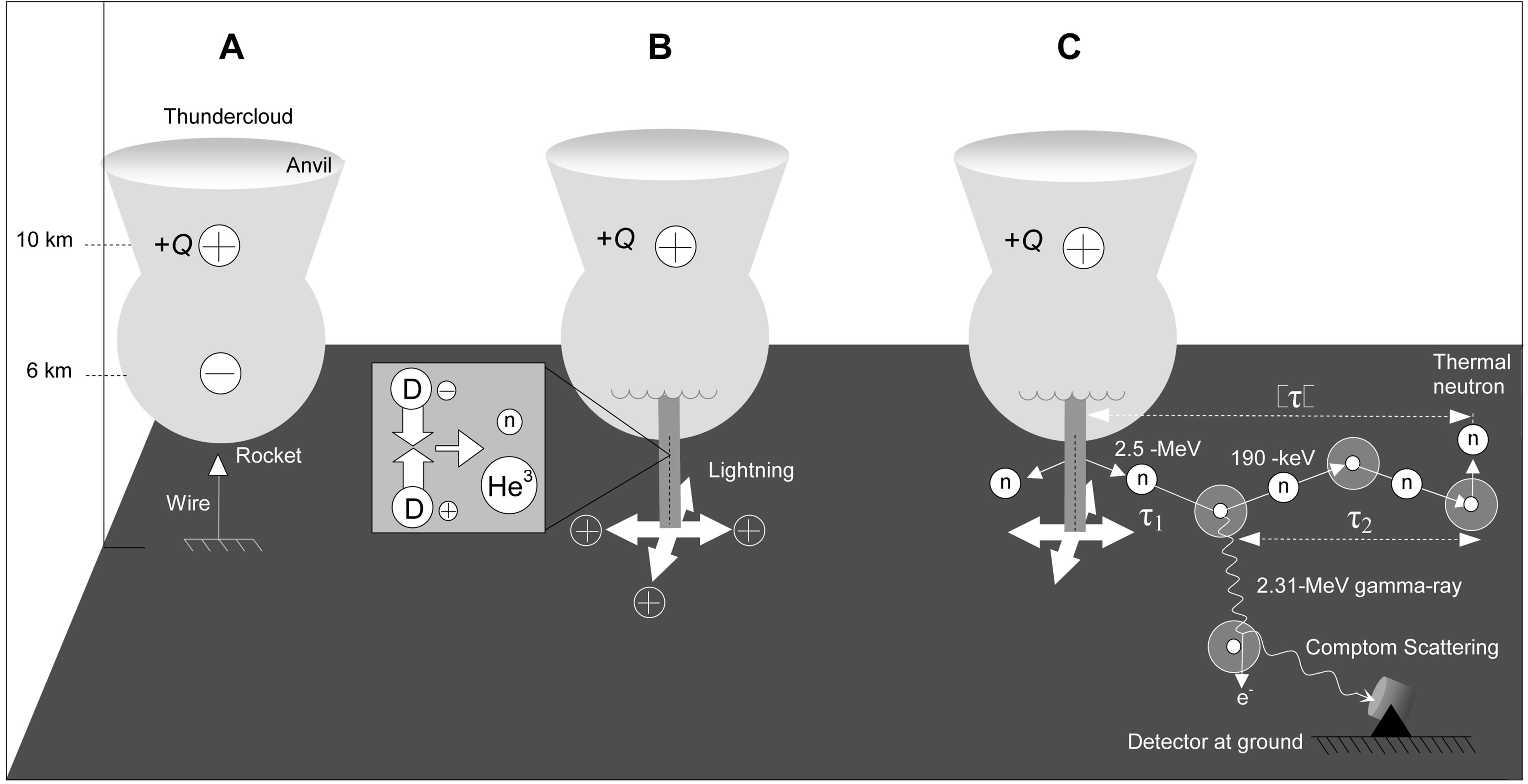
Figure 1. Mechanism for gamma-ray bursts on the ground, produced in association with rocket-triggered lightning. When the positive charge in the base of thundercloud is discharged by the rocket-triggered lightning (A); deuteron-deuteron fusion in the lightning channel (B) will produce neutrons. Gamma-rays (C) are produced by collisions of neutrons with air molecules. Compton scattering of these gamma-rays occurs producing the smooth gamma-ray energy spectrum detected at ground.
thermalization period in air occurring subsequent to the fast neutron burst and a thermal equilibrium. According to Samworth [19] thermalization time (Se Figure 1) of neutrons in a material is given by:
 (1)
(1)
where  is the macroscopic neutron capture cross section. It is the effective cross-sectional area per unit volume of material for capture of neutrons (in cm2/cm3 or cm−1), given by [19]:
is the macroscopic neutron capture cross section. It is the effective cross-sectional area per unit volume of material for capture of neutrons (in cm2/cm3 or cm−1), given by [19]:
 (2)
(2)
where σc is the microscopic neutron capture cross section and n is the particle density (i.e., number of atoms or molecules per volume unity of the absorber). Only hydrogen and nitrogen have significant cross sections for thermal neutron capture (0.33 and 1.75 barns, respectively [20]. In thunderstorm environment, there are high concentrations water molecules in the atmosphere. Thus, we should consider mean thermalization time, given by [19]:
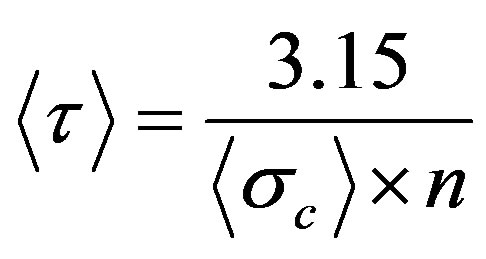 (3)
(3)
where  is the arithmetic mean of neutron capture cross section for hydrogen (from water) and nitrogen. Considering particle density in humid air as being [21]
is the arithmetic mean of neutron capture cross section for hydrogen (from water) and nitrogen. Considering particle density in humid air as being [21]
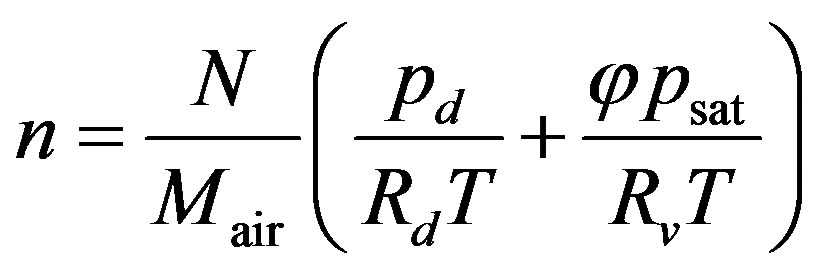 (4)
(4)
where N is the Avogadro number, M is the mean molar mass of air particles, pd is the partial pressure of dry air (Pa), Rd is the specific gas constant for dry air, 287.05 J/(kg·K), T is air temperature on the Kelvin scale, Rv is the specific gas constant for water vapor, 461.495 J/(kg·K),  is the relative humidity, and psat is the saturation vapor pressure. The saturation vapor pressure of water at any given temperature is the vapor pressure when relative humidity is 100%. A simplification of the regression used to find this, can be formulated as [22]:
is the relative humidity, and psat is the saturation vapor pressure. The saturation vapor pressure of water at any given temperature is the vapor pressure when relative humidity is 100%. A simplification of the regression used to find this, can be formulated as [22]:
 (5)
(5)
Inserting the numerical values in Equation (5), for T = 298 K and 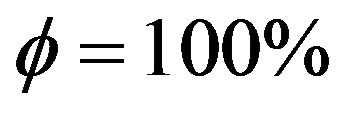 air humidity, we found n = 5 × 1025 m−3. Thus, we have
air humidity, we found n = 5 × 1025 m−3. Thus, we have 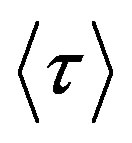 ~ 33 ms. The attenuation length or mean free path is the medium length of a path covered by a particle between subsequent impacts. The mean free path of neutron in an absorber (air) is given by [23]:
~ 33 ms. The attenuation length or mean free path is the medium length of a path covered by a particle between subsequent impacts. The mean free path of neutron in an absorber (air) is given by [23]:
 (6)
(6)
where sT is the total cross section of neutrons in the absorber. Thus, the time covered by a fast neutron between subsequent impacts is [23]:
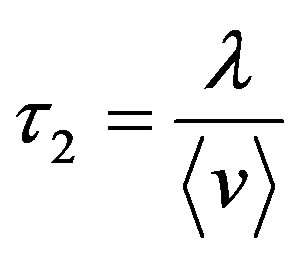 (7)
(7)
where ávñ is the mean speed of neutron. Thus [24],
 (8)
(8)
where c is the speed of light, Ek is the kinetic energy of neutron, and m is its rest mass.
For 190 KeV neutrons (See Figure 1), total cross-section of nitrogen is sT ~ 4 barn [23]. Inserting this values in Equaiton (8), we found t2 ~ 2 × 10−7 s (0.2 ms). Therefore, the time delay of gamma-ray bursts will be  ms. Thus, gamma-rays should not be seen on the ground immediately after the rocket-triggered lightning because neutrons (produced in lightning channel) will delay a definitive time (~33 ms) to cover the atmosphere before hitting a molecule and producing gamma rays. This value is in a good agreement with gamma-ray time delay (~20 ms) observed at ground by Dwyer et al. [25]. In nitrogen, inelastic scattering of neutrons produces 2.31 MeV gamma-rays [23]. Compton scattering of these gamma-rays should occur in the atmosphere, producing the smooth gamma-ray energy spectrum detected at ground. Attenuation of gamma ray flux through the air is governed by the Beer-Lambert law [26]:
ms. Thus, gamma-rays should not be seen on the ground immediately after the rocket-triggered lightning because neutrons (produced in lightning channel) will delay a definitive time (~33 ms) to cover the atmosphere before hitting a molecule and producing gamma rays. This value is in a good agreement with gamma-ray time delay (~20 ms) observed at ground by Dwyer et al. [25]. In nitrogen, inelastic scattering of neutrons produces 2.31 MeV gamma-rays [23]. Compton scattering of these gamma-rays should occur in the atmosphere, producing the smooth gamma-ray energy spectrum detected at ground. Attenuation of gamma ray flux through the air is governed by the Beer-Lambert law [26]:
 (9)
(9)
 (10)
(10)
where pa is the partial pressure of air (Pa, N/m2), and T is the absolute dry bulb temperature (K). The density of water vapor can be expressed as [21]:
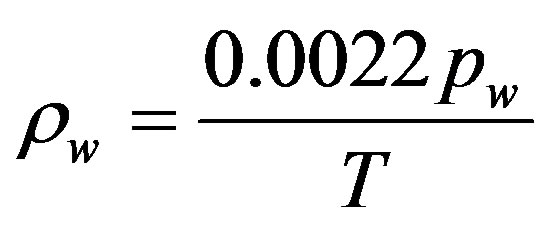 (11)
(11)
where pw is the partial pressure water vapor (Pa, N/m2), and T is the absolute dry bulb temperature (K). The amount of water vapor in air at ground level can vary between θw = 0% to about θw = 5% (for example, in thunderstorm conditions). On the other hand, the 2.31 MeV gamma-ray mass attenuation coefficients of dry air and water are respectively μa = 0.03 (cm2/g) and μw = 0.02 (cm2/g) [27]. Inserting the numerical values in Equaiton (9), for pa = pw = 105 Pa, T = 298 K, x = 650 m (burst of MeV gamma-rays was observed from a distance of 650 m from the lightning channel. See Ref. 1), and θw = 5%, we found I/I0 ~ 0.1. In the case of terrestrial gamma ray flashes (TGFs), assuming the photons are uniformly distributed over a disk of radius 300 km (given by the typical lightning-subsatellite distance), the 1 photon/cm2 fluence implies that of order 1015 photons reach satellite altitude. Full comparison of satellite observations to simulations of photon attenuation and scattering in the atmosphere requires a source of photons with 15 - 20 km altitude, and a total source of 1016 photons. This corresponds to a photon attenuation of I/I0 ~ 0.1. The amount of atmosphere above 6 km is about the same as the amount below that altitude [1]. Thus, in the case of gamma rays from triggered lightning, the photon attenuation can assume equal value estimated for TGFs (i.e., I/I0 ~ 0.1), in a good agreement with our calculations. Thus, we expect a total source of 1016 photons and 1015 photons reach the ground.
Electrical discharges through polymer fibers have been shown to produce up to 1012 neutrons by deuteron-deuteron fusion in dense plasma, consistent with ion densities of about 1019 cm−3 [28] and peak voltages of about 0.6 MV across the plasma [15]. Similarly, ion density in lightning return strokes is of about 3 × 1018 cm−3 [29] with peak voltages between 10 and 100 MV across the plasma [30]. Finally, natural deuterium abundance
(0.015%) is identical in both water (for example, water droplets of cloud) and polymer molecules [15]. Thus, considering the parameters above for both exploding polymer fibers and lightning discharge, it is perfectly plausible the idea of accelerating ions inside a lightning channel to sufficient energies to cause nuclear reactions.
The “classical” lightning-triggering technique involves the use of a small rocket extending a thin grounded wire upward made of Kevlar-coated copper [2]. Gamma rays occur 20 ms after the vaporization of the triggering wire in rocket-triggered lightning [1]. According to diagrams based on the triggered lightning events [31,32], high energy upward ions (with velocities between 107 and 108 m/s) can be produced on the tip of the grounded copper wire (Figure 2) after the vaporization of the triggering wire due to highly polarized floating channel.
In this case, natural deuterium atoms from Kevlar are transformed in relativistic ions, producing neutrons by nuclear reactions after the wire disintegration.
3. Conclusions
According to our work, gamma-rays are produced by collisions of fast neutrons with air molecules. In triggered lightning, gamma-rays appear in about 33 ms after the lightning, in a good agreement with gamma-ray time delay observed at ground, which is 20 ms [1]. That is the mean time that the neutrons lead before colliding with a molecule of air to generate gamma-rays. Compton scat
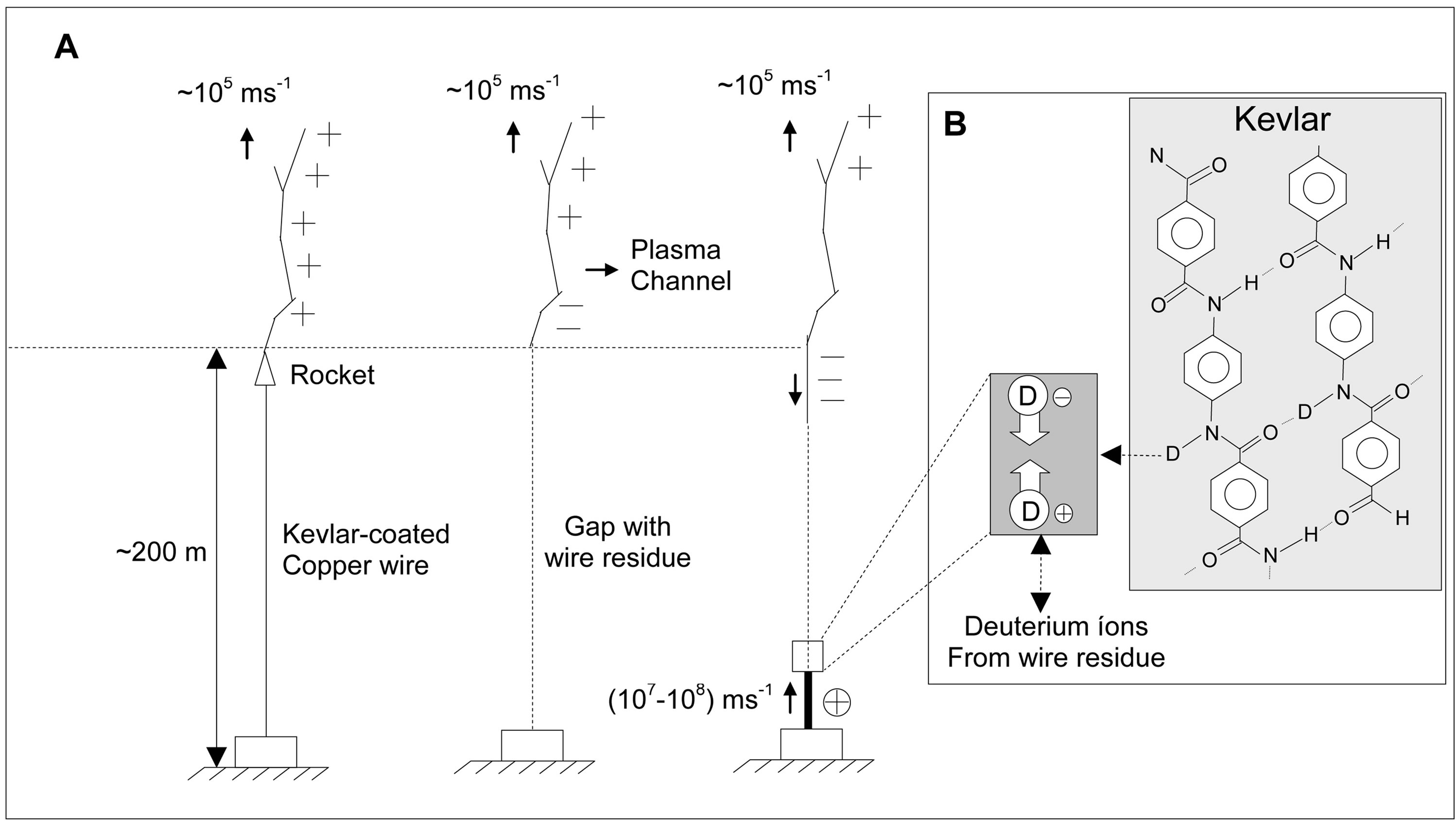
Figure 2. Mechanism for the neutron production after the disintegration of Kevlar-coated copper wire by a triggered lightning discharge (A); Kevlar is a natural source of deuterium ions for nuclear reaction in lightning channel (B).
tering of the line emission should occur for the spectrum reported.
According to our model, one should expect an excess of He3—the other product of the D-D fusion reaction— near the lower levels of thunderclouds. If detection of this excess would be possible, it would provide further proof of the proposed mechanism. An effort in exploring such suggestion is in progress.
4. Acknowledgements
We acknowledge financial support from CNPq and Faperj (Brazil). The authors would like to express great appreciation to Dr. Sebastião Florentino da Silva (PROINFA from Eletrobrás, Rio de Janeiro, Brazil) for his encouragement and advice to this work.
REFERENCES
- J. R. Dwyer, H. K. Rassoul, M. Al-Dayeh, L. Caraway, B. Wright, A. Chrest, M. A. Uman, V. A. Rakov, K. J. Rambo, D. M. Jordan, J. Jerauld and C. Smyth, “A Ground Level Gamma-Ray Burst Observed with Rocket-Triggered Lightning,” Geophysical Research Letters, Vol. 31, No. 5, 2004, Article ID: L05119. http://dx.doi.org/10.1029/2003GL018771
- D. Wang, V. A. Rakov, M. A. Uman, N. Takagi, T. Watanabe, D. Crawford, K. J. Rambo, G. H. Schnetzer, R. J. Fisher and Z. I. Kawasaki, “Attachment Process in Rocket-Triggered Lightning Strokes,” Journal of Geophysical Research, Vol. 104, No. D2, 1999, pp. 2143-2150. http://dx.doi.org/10.1029/1998JD200070
- M. Brunetti, S. Cecchini, M. Galli, G. Giovannini and A. Pagliarin, “Gamma-Ray Bursts of Atmospheric Origin in the MeV Energy Range,” Geophysical Research Letters, Vol. 27, No. 11, 2000, pp. 1599-1602. http://dx.doi.org/10.1029/2000GL003750
- K. B. Eack, W. H. Beasley, W. D. Rust, T. C. Marshall and M. Stolzenburg, “Initial Results from Simultaneous Observation of X Rays and Electric Fields in a Thunderstorm,” Journal of Geophysical Research, Vol. 101, No. D23, 1996, pp. 29637-29640. http://dx.doi.org/10.1029/96JD01705
- D. M. Suszcynsky, R. Roussel-Dupré and G. Shaw, “Ground-Based Search for X-Rays Generated by Thunderstorms and Lightning,” Journal of Geophysical Research, Vol. 101, No. D18, 1996, pp. 23505-23516. http://dx.doi.org/10.1029/96JD02134
- C. B. Moore, K. B. Eack, G. D. Aulich and W. Rison, “Energetic Radiation Associated with Lightning SteppedLeaders,” Geophysical Research Letters, Vol. 28, No. 11, 2001, pp. 21412144. http://dx.doi.org/10.1029/2001GL013140
- C. T. R. Wilson, “The Electric Field of a Thundercloud and Some of Its Effects,” Proceedings of the Physical Society of London, Vol. 37, No. 1, 1924, pp. 32D-37D. http://dx.doi.org/10.1088/1478-7814/37/1/314
- J. R. Dwyer and D. M. Smith, “High-Energy Electron beams Launched into Space by Thunderstorms,” Geophysical Research Letters, Vol. 32, 2005, Article ID: L22804.
- J. R. Dwyer, “The Source Mechanisms of Terrestrial Gamma-Ray Flashes (TGFs),” Journal of Geophysical Research, Vol. 113, No. D10, 2008, Article ID: D10103. http://dx.doi.org/10.1029/2007JD009248
- V. P. Pasko, U. S. Inan and T. F. Bell, “Fractal Structure of Sprites,” Geophysical Research Letters, Vol. 27, No. 4, 2000, pp. 497-500. http://dx.doi.org/10.1029/1999GL010749
- L. P. Babich, A. Yu. M. L. Kudryavtsev, I. Kudryavtseva and M. Kutsyk, “Terrestrial Gamma-Ray Flashes and Neutron Pulses from Direct Simulations of Gigantic Upward Atmospheric Discharge,” JETP Letters, Vol. 85, No. 10, 2007, pp. 483-487. http://dx.doi.org/10.1134/S0021364007100037
- G. S. Paiva, “Terrestrial Gamma-Ray Flashes Caused by Neutron Bursts above Thunderclouds,” Journal of Applied Physics, Vol. 105, No. 8, 2009, Article ID: 083301. http://dx.doi.org/10.1063/1.3089230
- L. S. Bratolyubova-Tsulukidze, E. A. Grachev, O. R. Grigoryan, V. E. Kunitsyn, B. M. Kuzhevskij, D. S. Lysakov, O. Yu Nechaev and M. E. Usanova, “Thunderstorms as the Probable Reason of High Background Neutron Fluxes at L < 1.2,” Advances in Space Research, Vol. 34, No. 8, 2004, pp. 1815-1818. http://dx.doi.org/10.1016/j.asr.2003.03.044
- L. M. Libby and H. R. Lukens, “Production of Radiocarbon in Tree Rings by Lightning Bolts,” Journal of Geophysical Research, Vol. 78, No. 26, 1973, pp. 5902-5903. http://dx.doi.org/10.1029/JB078i026p05902
- S. J. Stephanakis, L. S. Levine, D. Mosher, I. M. Vitkovitsky and F. Young, “Neutron Production in ExplodingWire Discharges,” Physical Review Letters, Vol. 29, No. 9, 1972, pp. 568-569. http://dx.doi.org/10.1103/PhysRevLett.29.568
- I. M. Vitkovitsky, L. S. Levine, D. Mosher and S. J. Stephanakis, “Dense Plasma Discharges for Solid Target Heating,” Applied Physics Letters, Vol. 23, No. 1, 1973, pp. 9-11. http://dx.doi.org/10.1063/1.1654736
- A. V. Gurevich, V. P. Antonova, A. P. Chubenko, A. N. Karashtin, G. G. Mitko, M. O. Ptitsyn, V. A. Ryabov, A. L. Shepetov, Yu. V. Shlyugaev, L. I. Vildanova and K. P. Zybin, “Strong Flux of Low-Energy Neutrons Produced by Thunderstorms,” Physical Review Letters, Vol. 108, No. 12, 2012, Article ID: 125001. http://dx.doi.org/10.1103/PhysRevLett.108.125001
- L. P. Bradley and G. W. Kuswa, “Neutron Production and Collective Ion Acceleration in a High-Current Diode,” Physical Review Letters, Vol. 29, No. 21, 1972, pp. 1441- 1145. http://dx.doi.org/10.1103/PhysRevLett.29.1441
- J. R. Samworth, “Method of Logging a Borehole,” US Patent 7102125, 2006.
- C. S. Wuu, H. I. Amols, P. Kliauga, L. E. Reinstein and S. Saraf, “Microdosimetry for Boron Neutron Capture Therapy,” Radiation Research, Vol. 130, No. 3, 1992, pp. 355-359. http://dx.doi.org/10.2307/3578381
- G. Christ, O. S. Dohm, E. Schüle, S. Gaupp and M. Martin, “Air Density Correction in Ionisation Dosimetry,” Physics in Medicine and Biology, Vol. 49, No. 10, 2004, p. 2029. http://dx.doi.org/10.1088/0031-9155/49/10/013
- Equations, Air Density and Density Altitude, “An Introduction to Air Densityand Density Altitude Calculations,” 2012. http://wahiduddin.net/calc/density_altitude.htm
- I. Kaplan, “Nuclear Physics,” Addison-Wesley, Reading, 1971, p. 581.
- P. Tipler and R. Llewellyn, “Modern Physics,” 4th Edition, W. H. Freeman, New York, 2002.
- J. R. Dwyer, “The Source Mechanisms of Terrestrial Gamma-Ray Flashes (TGFs),” Journal of Geophysical Research, Vol. 113, No. D10, 2008, Article ID: D10103. http://dx.doi.org/10.1029/2007JD009248
- A. Poskus, “Attenuation of Gamma Rays,” 2012. http://www.kkek.ff.vu.lt/uploads/erasmus/no10.pdf
- J. H. Hubbell, “Photon Mass Attenuation and EnergyAbsorption Coefficients from 1 keV to 20 MeV,” The International Journal of Applied Radiation and Isotopes, Vol. 33, No. 11, 1982, pp. 1269-1290. http://dx.doi.org/10.1016/0020-708X(82)90248-4
- F. C. Young, S. J. Stephanakis, I. M. Vitkovitsky and D. Mosher, “Neutron Production by Hot Dense Plasmas Generated with High Power Pulsers,” IEEE Transactions on Nuclear Science, Vol. 20, No. 1, 1973, pp. 439-445. http://dx.doi.org/10.1109/TNS.1973.4326944
- M. A. Uman, R. E. Orville and L. E. Salanave, “The Density, Pressure, and Particle Distribution in a Lightning Stroke near Peak Temperature,” Journal of the Atmospheric Sciences, Vol. 21, No. 3, 1964, pp. 306-310. http://dx.doi.org/10.1175/1520-0469(1964)021<0306:TDPAPD>2.0.CO;2
- M. A. Uman, “Lightning,” Dover, New York, 1969, p. 215.
- V. A. Rakov, M. A. Uman and K. J. Rambo, “A Review of Ten Years of Triggered Lightning Experiments at Camp Blanding, Florida,” Atmospheric Research, Vol. 76, No. 1-4, 2005, pp. 503-517. http://dx.doi.org/10.1016/j.atmosres.2004.11.028
- P. Lalande, A. Bondiou-Clergerie, P. Laroche, A. EybertBerard, J.-P. Berlandis, B. Bador, A. Bonamy, M. A. Uman and V. A. Rakov, “Leader Properties Determined with Triggered Lightning Techniques,” Journal of Geophysical Research, Vol. 103, No. 12, 1998, pp. 14109- 14115. http://dx.doi.org/10.1029/97JD02492

